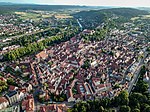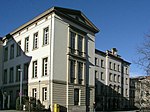Neckarinsel, Tübingen
AC with 0 elementsGeography of TübingenIslands of Baden-WürttembergPages with unreviewed translationsUninhabited islands of Germany

The Neckarinsel (Neckar Island) in Tübingen, Germany is an artificial, ⅔ mile long Neckar river island, which was created in the years 1910 and 1911 by branching off a parallel channel to regulate the water level of the Neckar river. It extends from the headland west of the Ammertal train bridge, the so-called Bügeleisen (Flatiron), to the Eberhard Bridge.
Excerpt from the Wikipedia article Neckarinsel, Tübingen (License: CC BY-SA 3.0, Authors, Images).Neckarinsel, Tübingen
Platanenallee,
Geographical coordinates (GPS) Address Nearby Places Show on map
Geographical coordinates (GPS)
| Latitude | Longitude |
|---|---|
| N 48.517777777778 ° | E 9.0519444444444 ° |
Address
Platanenallee
72072 , Universität
Baden-Württemberg, Germany
Open on Google Maps










